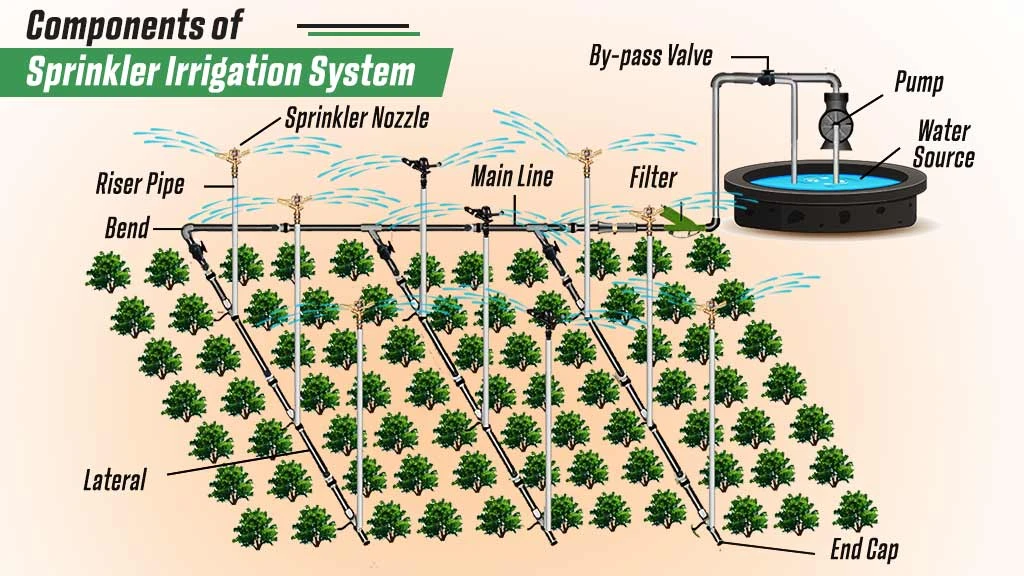Sprinkler Irrigation in India: A Modern Irrigation Method

Have you ever thought why methods like sprinkler irrigation was introduced even though we already had traditional irrigation methods like flood irrigation. In this blog, we will understand the need of sprinkler irrigation and how it works, along with its benefits in detail.
Table of Contents
- What is Sprinkler Irrigation?
- Savings & Productivity Improvement with Usage of Sprinkler
- Types of Sprinkler Irrigation
- Components of Sprinkler Irrigation System
- Points to be considered while Setup Sprinkler Irrigation System
- Advantages of Sprinkler Irrigation
- Challenges in Sprinkler Irrigation
- Cost of Setting up 1 Hectare Sprinkler System
What is Sprinkler Irrigation?
Sprinkler irrigation is a method of applying irrigation water which is like natural rainfall. Water is distributed through a system of pipes usually by pumping. It is then sprayed into the air through sprinklers so that it breaks up into small water drops which fall to the ground. It is used on uneven land where there is less water as well as on sandy soil.
Sprinkler irrigation is one of the advanced methods of irrigation system. Sustainable agriculture and increasing incomes of farmers is the focus of the government that is why the government is increasing water productivity in agriculture. Micro irrigation covers almost an area of 78 lakh hectare from 2015-16 to till date.
Savings & Productivity Improvement with Usage of Sprinkler
|
Crops |
Water Saving (%) |
Yield Increase (%) |
|
Barley |
56 |
16 |
|
Bajra |
56 |
19 |
|
Ladyfinger |
28 |
23 |
|
Chillies |
33 |
24 |
|
Cauliflower |
35 |
12 |
|
Cotton |
36 |
50 |
|
Fenugreek |
29 |
35 |
|
Jowar |
55 |
34 |
|
Gram |
69 |
57 |
|
Wheat |
35 |
24 |
|
Maize |
41 |
36 |
|
Onion |
33 |
23 |
Types of Sprinkler Irrigation
The types of sprinkler irrigation are as follows:
- Based on the arrangement for spraying irrigation water
- Rotating head or revolving sprinkler system
- Perforated pipe system
- Based on portability
- Portable system
- Semi-portable system
- Semi-permanent system
- Solid set system
- Permanent system
Components of Sprinkler Irrigation System
- A pump unit
- Tubing- main/submains and laterals
- Couplers
- Sprinkler head
- Other accessories such as valves, bends, plugs and risers

Points to be considered while setting up Sprinkler Irrigation System
- Choose the right kind of sprinkler system based on the crop and water requirements.
- Pick the right pump head according for the irrigation according to your field. Consider points like field coverage area and the flow rate.
- The spacing of your sprinkler units or pipes should be spaced as per your field crop and agro-mechanical vehicles and tools used.
- You should buy a sprinkler system which can make even distribution patterns and can reach the required distance in your field size, but make sure there is no use of aggressive jets as they can injure young crops, expose seeds and create soil erosion or provoke soil crusting.
Advantages of Sprinkler Irrigation
- Saves water up to 30%
- Helps to increase yield
- Suitable for irrigating crops
- Suitable to all types of soil except heavy clay
- Saves land as no bunds are required
- Eliminates water conveyance channels thereby reduces conveyance loss
- Areas located at a higher elevation than the source can be irrigated
- Less problem of clogging of sprinkler nozzles due to sediment laden water
- Mobility of system
Challenges in Sprinkler Irrigation
- Evaporation loss when operating under high temperatures
- Uneven water distribution leads to difficulty in irrigation due to high winds
- High initial cost
- Highly impermeable soils are not suitable
- High water pressure requirement (>2.5kg/cm2)
Cost of Setting up 1 Hectare Sprinkler System
As per NABARD, the estimated cost for setting up 1 hectare (ha) sprinkler system is mentioned below.
|
Sl. No. |
Product Description |
Amount (in Rupees) |
|
|
Pump Set |
20,000 |
|
|
PVC Pipes |
56,096 |
|
|
Control Valve |
4,450 |
|
|
Sprinkler Assembly |
18,900 |
|
|
Screen Filter |
4,500 |
|
|
Fitting and Accessories |
4,197 |
|
|
Total |
108,000 |
For the technical support and financial assistance for the farmers, Government of India came up with various schemes and initiatives for irrigation purposes. One such scheme is Pradhan Mantri Krishi Sinchayee Yojana (PMKSY) which aims to enhance physical access of water on farm and expand cultivable area under assured irrigation, improve on-farm water use efficiency, introduce sustainable water conservation practices, etc. The extension of PMKSY for 2021-22 to 2025-26 has been approved with an overall outlay of Rs. 93,068 crores.
Frequently Asked Questions On Sprinkler Irrigation in India: A Modern Irrigation Method
1. What is irrigation sprinkler?
Irrigation sprinkler is a device used to irrigate (water) agricultural crops, lawns, landscapes, golf courses, and other areas.
2. Where is sprinkler irrigation used in India?
Sprinkler irrigation is used where there is less water availability as well as on almost all kind of soils except heavy clay soil.
3. Which state has highest sprinkler irrigation in India?
Rajasthan is the most irrigated state through sprinkler irrigation due to water shortage.
4. Which soil is best suited for sprinkler irrigation in India?
Light sandy soils are the best soil for sprinkler irrigation in India.
5. What is the advantage of sprinkler irrigation?
Sprinkler irrigation is suitable to almost all types of soils, saves water and increases yield.


Related Blogs












